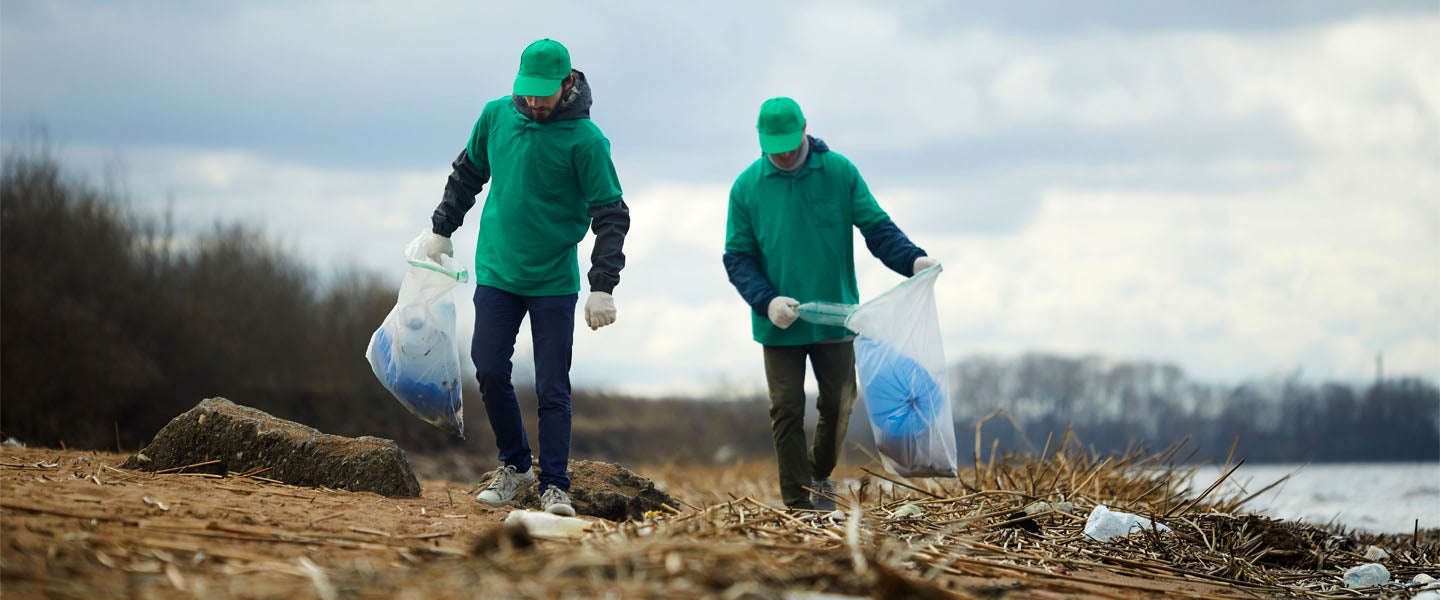Jon Dolias is Chicago’s garbage vigilante. Five to six times a week, he goes around town with a bright orange Home Depot bucket and a long, silver grabber snatching every piece of trash he spots — from used needles, to McDonald’s cups, to bottles of Jay-Z’s D’USSÉ cognac. Most mornings, he brings along his 8-year-old dog named Penny. Each time she stops to sniff, Dolias picks a few pieces of trash. “I find zip ties everywhere. I found 40 something yesterday just going for a quick little walk,” he says. In fact, before he’s even had his morning coffee, Dolias routinely collects around 8 pounds of debris. “This is going to sound super crunchy,” he tells me. “But it helps me center myself. I’ve done something good, and I can continue to do that today.”
He also was, last week at least, part of a new viral movement — the #TrashTag challenge, or before-and-after photos of people showing off their efforts to clean up rivers, roadways and other public spaces. Facebook user Byron Román originated the #Trashtag challenge when he posted one such collage of a park he’d cleaned up. He captioned it, “Here is a new #challenge for all you bored teens. Take a photo of an area that needs some cleaning or maintenance, then take a photo after you have done something about it, and post it.”
Though the #TrashTag hashtag has existed for a few years, Roman decided to make it his own. As he told TIME, “When teens get bored, that’s like the worst thing you can ever have — actually, any person being bored. So, I thought, maybe someone will pick up the challenge and do something positive about it.” To date, it’s garnered more than 30,000 tags on Twitter.
At 20, Jephthah Eernisse is no longer a teen (bored or otherwise), though last week he found himself scrolling through Reddit while on spring break from LeTourneau University in Texas. He stumbled across several posts about #TrashTag and was inspired. He quickly called up his high school buddy, Luis, and together, they ventured to Little Thicket Park near his home in Houston. He originally planned on bringing only one large trash bag, but Luis encouraged him to bring a few extra just in case. In total, they filled nearly four bags, unearthing a rug, part of a plastic slide and even a drain cover in the process. Eernisse’s biggest find, though: a Texas Longhorns folding chair sitting underneath a pile of debris. “It was in really good condition, except it was really dirty,” he says. “Somebody brought that chair out there and just left it. It’s weird how much stuff piles up out there.”
As a mechanical engineering major who aspires to create solutions for the environmental crisis, Eernisse is particularly worried about the trash caught in sewers and resting on riverbanks. For example, a creek courses through the southern edge of Little Thicket, draining into the Buffalo Bayou river. And so, when it rains, loose trash slowly floats all the way down from the park to the Gulf of Mexico. He is then doing his part to prevent a Longhorns folding chair (or plastic slide, or rug) from making its way into the ocean. But, as with Dolias, picking up all that stuff just makes him feel good, too. “It feels nice to look at a place that looks really ugly because of trash and then see it again an hour later and it looks so much better,” he explains.
For 15 years, Jesse Johnson, who collected garbage for the first time Sunday afternoon after seeing #TrashTag trending, has gone cliff-jumping in High Rocks City Park just outside of Portland, Oregon. The literal watering hole is a favorite for local high schools, and on the occasional hot summer day, Johnson can still be found hanging on the rocks, which are typically littered with empty sunscreen and beer bottles. “Every single year, it’s covered in trash,” he says.
Thus, on Sunday, he called his friend Armando, and after a brief stop at the store to pick up plastic bags and gloves, they headed down to the banks of the Clackamas River at the base of the park. While his chocolate lab Monkey waded in the water, the duo filled six trash bags in two-and-a-half hours. “We didn’t have to go out of our way once we got there,” he says. “If you look further down the river, there’s definitely a lot more. We kind of held off.” Johnson estimates that 95 percent of what they found (paper wrappers, broken glass, a torn-up inner-tube), came from high schoolers not picking up after themselves. He knows because he used to be one of them.
As for Dolias, he plans to hit the street hard with Penny this spring. His goal: 1,000 pounds of trash by the end of the year. He’s already halfway there, hitting approximately 500 last week. The neighbors are certainly starting to notice: “People come up and thank me.” But Chicago’s premier picker is adamant about not sounding self-righteous. “I’m just like some schmuck whose picking up trash,” he says. “Anybody can do it.”

